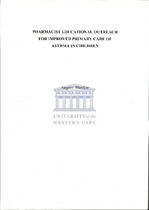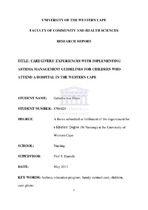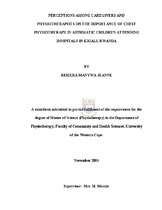| dc.contributor.advisor | Zwarenstein, M F | |
| dc.contributor.author | Bheekie, Angeni | |
| dc.date.accessioned | 2021-10-13T11:55:36Z | |
| dc.date.available | 2021-10-13T11:55:36Z | |
| dc.date.issued | 2001 | |
| dc.identifier.uri | http://hdl.handle.net/11394/8520 | |
| dc.description | Doctor Pharmaceuticae - DPharm | en_US |
| dc.description.abstract | Underdiagnosis and undertreatment of asthma in children are barriers to optimal health care delivery and health, incurring substantial costs to both the families and health services. A tailored multifaceted educational outreach intervention ("academic detailing") was designed and implemented among private sector general practitioners (GPs) serving a poor working class urban community in Cape Town, South Africa. The
intervention aimed to improve primary care childhood asthma by promoting the adoption of guideline-based key messages. The effectiveness of the intervention was tested in a randomised controlled trial, Chestiness and Asthma in Mitchell's Plain (CHAMP) (Zwarenstein 1999). This thesis describes the design, implementation and qualitative evaluation of the outreach intervention. Methods
Qualitative interviews and quantitative sample surveys were conducted among GPs to identify and measure the prevalence of perceived barriers to optimal asthma care in children. A trained pharmacist visited GPs twice, promoting eight evidence-based primary care messages to overcome barriers to optimal care for asthma in children. The messages focused on key diagnostic indicators, a treatment algorithm based on severity, cost of drug therapies, inhaler and spacer use, and preventive treatment. These messages were formatted into attractive promotional material. The first visit promoted use of the messages, the second reinforced adoption in routine practice and assessed GPs'
responses using unobtrusive qualitative data collection methods. The dialogue was tailored to each GP's needs. Results Thirty-two GPs received the intervention. All but one consented to both visits. At the first visit responses were varied. A few GPs were confused or suspicious; most were in agreement with the messages but seemed passive towards implementation; a few were keen to adopt the messages into their routine practice. Response at first visit was not predictive of use as assessed at the second. At the second visit, most GPs claimed that they personally agreed with and used the messages, with a large minority less enthusiastic. Conclusion The intervention appears to have been broadly accepted as evident from GPs' acceptance of the outreach pharmacist, but reports of complete adoption of the messages and use of the kit were less prevalent. This finding is consistent with and helps to explain the improved health outcomes of children with asthma in the CHAMP trial. The combination of qualitative and quantitative research methods was effective in identifying and assessing GPs' barriers. Further, the combination helped to confirm the determinants for the intervention. Unobtrusive qualitative methods provided valuable
insight into GP behaviour in routine setting. Additional studies conducted in public sector pnmary care settings and for other diseases are needed to confirm the wider acceptability and effectiveness of multifaceted outreach interventions aimed at improving professional practice. Such an intervention in our study setting seemed successful for childhood asthma. | en_US |
| dc.language.iso | en | en_US |
| dc.publisher | University of the Western Cape | en_US |
| dc.subject | National Asthma Education Programme (NAEP) | en_US |
| dc.subject | Peak Expiratory Flow (PEF) | en_US |
| dc.subject | International Study of Asthma and Allergies in Childhood (ISAAC) | en_US |
| dc.subject | Allergy Society of South Africa (ALLSA) | en_US |
| dc.subject | Global Initiative Global Initiative for Asthma (GINA) | en_US |
| dc.subject | National Heart, Lung and Blood Institute (NHLBI) | en_US |
| dc.subject | World Health Organisation (WHO) | en_US |
| dc.subject | Bronchial asthma | en_US |
| dc.subject | Cardiac asthma | en_US |
| dc.subject | Chestiness and Asthma in Mitchell's Plain (CHAMP) | en_US |
| dc.title | Pharmacist educational outreach for improved primary care of asthma in children | en_US |
| dc.rights.holder | University of the Western Cape | en_US |



